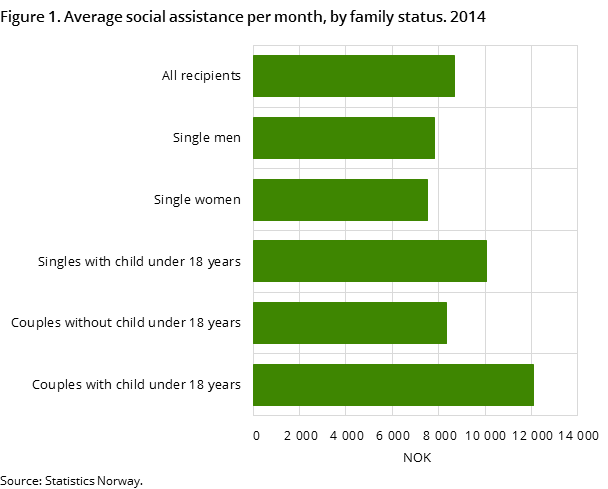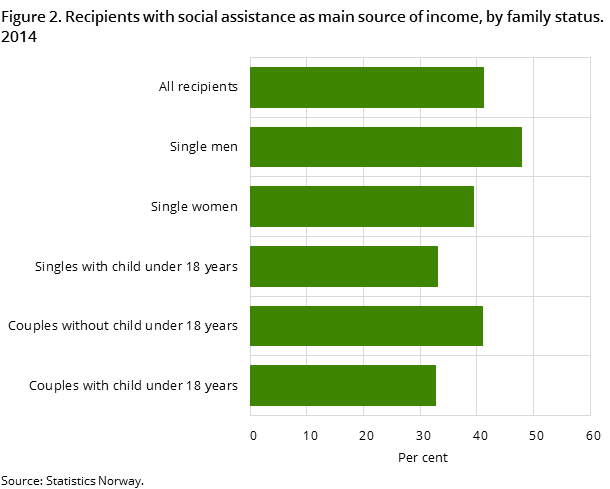Content
Published:
This is an archived release.
Continued growth in social assistance last year
In 2014, there were 125 400 recipients of social assistance; 4 per cent more than the year before. Payments were up 6 per cent when controlled for the general increase in prices.
| 2014 | |
|---|---|
| Recipients of social assistance | 125 407 |
| Single males total | 49 153 |
| Single females total | 28 891 |
| Social assistance as primary source of income | 51 724 |
| Expenditure on social assistance (1 000 NOK) | 5 596 057 |
| Average payment per month | 8 683 |


The increase in the number of social assistance recipients in 2013 continued last year. Although the scale of the increase was somewhat more moderate, the number of recipients was up by 4 500, and total payments reached NOK 5.6 billion. The average assistance period was stable at 5.1 months, while expenditure per month was up 2 per cent when controlled for price increases.
Continuing increase in numbers with social assistance as main source of income
The proportion of recipients with social assistance as their main source of income showed a downward trend during the years 2006-2011. The last three years, however, have seen increasing numbers; an increase of half a percentage point each year. The increasing numbers have been linked to a falling number of recipients on qualification programmes and measures aimed at persons with high social assistance dependency. Last year’s increase in dependency, however, is somewhat stronger than the reduced number of qualification programme participants.
The level of payments is clearly linked to size of municipality, reflecting differences in the cost of living. Recipients in cities with more than 50 000 inhabitants received payments almost twice the amount of recipients in the smallest municipalities (less than 5 000 inhabitants). As for differences among the 19 counties, the northern county of Finnmark still had the highest number of recipients per capita. The central county of Møre og Romsdal had, as in 2013, the lowest proportion, which was less than half the level of Finnmark.
Recipients tend to be slightly older
During the last 10 years, there is a slight tendency towards a somewhat older population of social assistance recipients. The proportion of recipients below 20 years is falling, while there are proportionally more in the age group 20-29 years. Correspondingly, there is a slight shift away from the age group 30-39 years towards the group 40-49 years.
In total, 37 per cent of recipients are now below 30 years, while 18 per cent are 50 years and older. Single men made up 39 per cent and single women 23 per cent of all recipients. Fourteen per cent were single parents, 12 per cent were couples without children and 11 per cent couples with children.
As for the work force status of the recipients, a slightly decreasing proportion is full-time workers (now 5.4 per cent). The proportion working part-time is going up, however, making the total level of recipients in ordinary work rather stable at 12.5 per cent.
Three out of four recipients live in rented apartments
In 2014, the housing conditions of recipients were registered for the first time. Half of the recipients lived in a privately rented apartment or house, while more than a quarter lived in a municipally owned entity. Eight per cent owned their house or apartment themselves, while four per cent, or 5 000 recipients, were homeless or living in temporary conditions. The housing conditions vary significantly with size of the municipality: in one out of five municipalities, 20 per cent or more owned their own house, while there were practically no homeless recipients. The great majority of these municipalities had less than 4 000 inhabitants. In municipalities with 50 000 or more inhabitants, the picture is radically different: in 12 out of 15 municipalities in this group, more recipients were homeless than owning their own house. This picture, of course, is also related to the disparities in the cost of living depending on the size and central location of municipalities.
Contact
-
Unni Beate Grebstad
E-mail: unni.grebstad@ssb.no
tel.: (+47) 94 50 68 66
